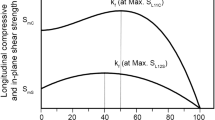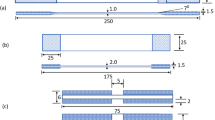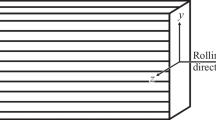Abstract
This work employs a micromechanical theory and kinematic relationships to describe the displacement field in individual unidirectional composite plies. The technique relies on an incremental approach where the misalignment angle of fibers is the main variable in the analysis. Upon convergence at a certain loading level, stresses and strains are evaluated in the fibers and matrix using micromechanics, and a specific failure criterion is applied. The Ramberg–Osgood relations are used to correct degraded mechanical properties of the resin in the nonlinear regime. The use of a 2D finite element model with a 3° initial misalignment angle of fibers, showed a good approach to complement the problem solution. The Hashin-Rotem failure criterion and experimental data obtained by Matsuo (Compos Part A: Appl Sci Manuf, 93:117-125, 2017) are used to validate the technique. It is observed that the numerical and experimental results obtained correlate well.









Similar content being viewed by others
References
Matsuo T, Kageyama K (2015) Investigation about temperature dependence of unidirectional compressive strength of carbon fiber reinforced thermoplastic composites. In Proceedings of ICCM-20 Conference, July 2015, Copenhagen, Denmark.
Rosen BW (1965) Mechanics of composite strengthening. In Fiber composite materials. American Society for Metals, 37–75, 1965.
Budiansky B (1983) Micromechanics. Comput Struct 16(1–4):3–12. https://doi.org/10.1016/0045-7949(83)90141-4
Hahn HT, Williams JG (1984) Compression failure mechanisms in unidirectional composites, NASA TM 85834, 1984.
Sun CT, Jun AW (1994) Compressive strength of unidirectional fiber composite with matrix non-linearity. Compos Sci Technol 52(4):577–587. https://doi.org/10.1016/0266-3538(94)90041-8
Budiansky B, Fleck NA (1993) Compressive failure of fibre composite. J Mech Phys Solids 41(1):183–211. https://doi.org/10.1016/0022-5096(93)90068-Q
Pimenta S, Gutkin R, Pinho ST, Robinson P (2009) A micromechanical model for kink band formation: part II–analytical modelling. Compos Sci Technol 69(7–8):956–964. https://doi.org/10.1016/j.compscitech.2009.02.003
Fleck NA, Liu D (2001) Microbuckle initiation from a patch of large amplitude fibre waviness in a composite under compression and bending. Eur J Mech A Solids 20(1):23–37. https://doi.org/10.1016/S0997-7538(00)01124-4
Gutkin R, Costa S, Olsson R (2016) A physically based model for kink-band growth and longitudinal crushing of composites under 3D stress states accounting for friction. Compos Sci Technol 135(27):39–45. https://doi.org/10.1016/j.compscitech.2016.09.002
Zhou L, Zhao L, Liu F, Zhang J (2018) A micromechanical model for longitudinal compressive failure in unidirectional fiber reinforced composite. Results Phys 10:841–848. https://doi.org/10.1016/j.rinp.2018.08.003
Vogler TJ, Kyriakides S (2001) On the initiation and growth of kink bands in fiber composites: Part I. experimental. Int J Solids Struct 38(15):2639–2651. https://doi.org/10.1016/S0020-7683(00)00174-8
Lee SH, Waas AM (1999) Compressive response and failure of fiber reinforced unidirectional composites. Int J Fract 100:275–306. https://doi.org/10.1023/A:1018779307931
Vogler TJ, Hsu S-Y, Kyriakides S (2001) On the initiation and growth of kink bands in fiber composites. Part II: analysis. Int J Solids Struct 38(15):2653–2682. https://doi.org/10.1016/S0020-7683(00)00175-X
Bogetti TA, Staniszewski J, Burns BP, Hoppel CPR, Gillespie JW Jr, Tierney J (2012) Predicting the nonlinear response and progressive failure of composite laminates under tri-axial loading. J Compos Mater 46(19–20):2443–2459. https://doi.org/10.1177/0021998312449889
Chou PC, Carleone J, Hsu CM (1972) Elastic constants of layered media. J Compos Mater 6(1):80–93. https://doi.org/10.1177/0021998372006001
Bogetti TA, Hoppel CPR, Drysdale WH (1995) Three-dimensional effective property and strength prediction of thick laminated composite media. ARL-TR-911, U.S. army research laboratory, Aberdeen Proving Ground, MD, October 1995.
Richard RM, Blacklock JR (1969) Finite element analysis of inelastic structures. AIAA J 7:432–438. https://doi.org/10.2514/3.5125
Matsuo T, Kageyama K (2017) Compressive failure mechanism and strength of unidirectional thermoplastic composites based on modified kink band model. Compos A Appl Sci Manuf 93:117–125. https://doi.org/10.1016/j.compositesa.2016.11.018
Vignoli LL, Savi MA, Pacheco PMCL, Kalamkarov AL (2020) Micromechanical analysis of longitudinal and shear strength of composite laminae. J Compos Mater 54(30):4853–4873. https://doi.org/10.1177/00219983209363
Zhang D, Waas AM (2014) A micromechanics based multiscale model for nonlinear composites. Acta Mech 225:1391–1417. https://doi.org/10.1007/s00707-013-1057-1
Huang ZM (2001) Micromechanical prediction of ultimate strength of transversely isotropic fibrous composites. Int J Solids Struct 38(22–23):4147–4172. https://doi.org/10.1016/S0020-7683(00)00268-7
Gutkin R, Pinho ST, Robinson P, Curtis PT (2011) A finite fracture mechanics formulation to predict fibre kinking and splitting in CFRP under combined longitudinal compression and in-plane shear. Mech Mater 43(11):730–739. https://doi.org/10.1016/j.mechmat.2011.08.002
Kaw AK (2005) Mechanics of composite materials. Taylor & Francis, 2nd edition, 2005.
Ramberg W, Osgood WR (1943) Description of stress-strain curves by three parameters. Technical Note No. 902, national advisory committee for aeronautics, Washington DC, 1943.
[2f5] Siemens Digital Industries Software, Femap – Finite Element Modeling and Postprocessing, Version 2021.2 MP1
MSC (2008) Software Corporation, Quick Reference Guide, MSC Nastran 2008 r1, Santa Ana, CA.
Matsuo T, Kageyama K (2013). Design and manufacture of anisotropic hollow beam using thermoplastic composites. In 19th international conference on composite materials, Montreal. 28th July - 02nd August 2013.
Hashin Z, Rotem A (1973) A fatigue failure criterion for fibre reinforced materials. J Compos Mater 7(4):448–464. https://doi.org/10.1177/002199837300700404
Funding
Partial financial support was received from agency CNPq (Grant 310742/2020-0).
Author information
Authors and Affiliations
Corresponding author
Ethics declarations
Conflict of interest
The authors have no competing interests to declare that are relevant to the content of this article.
Additional information
Technical Editor: Tulio H. Panzera.
Publisher's Note
Springer Nature remains neutral with regard to jurisdictional claims in published maps and institutional affiliations.
Rights and permissions
Springer Nature or its licensor (e.g. a society or other partner) holds exclusive rights to this article under a publishing agreement with the author(s) or other rightsholder(s); author self-archiving of the accepted manuscript version of this article is solely governed by the terms of such publishing agreement and applicable law.
About this article
Cite this article
de Faria, A.R., Arakaki, F.K. A practical technique to assess the influence of the misalignment angle of unidirectional composite fibers under compressive load. J Braz. Soc. Mech. Sci. Eng. 45, 246 (2023). https://doi.org/10.1007/s40430-023-04137-6
Received:
Accepted:
Published:
DOI: https://doi.org/10.1007/s40430-023-04137-6




